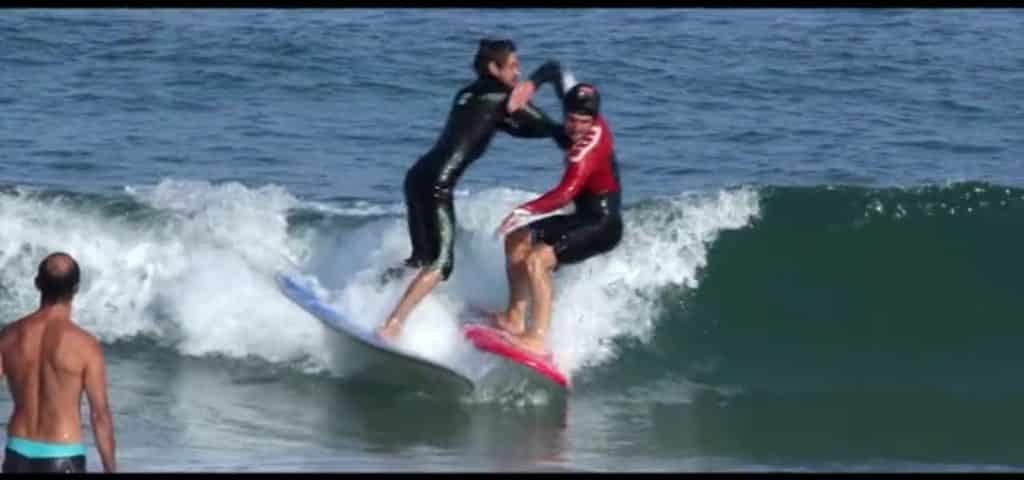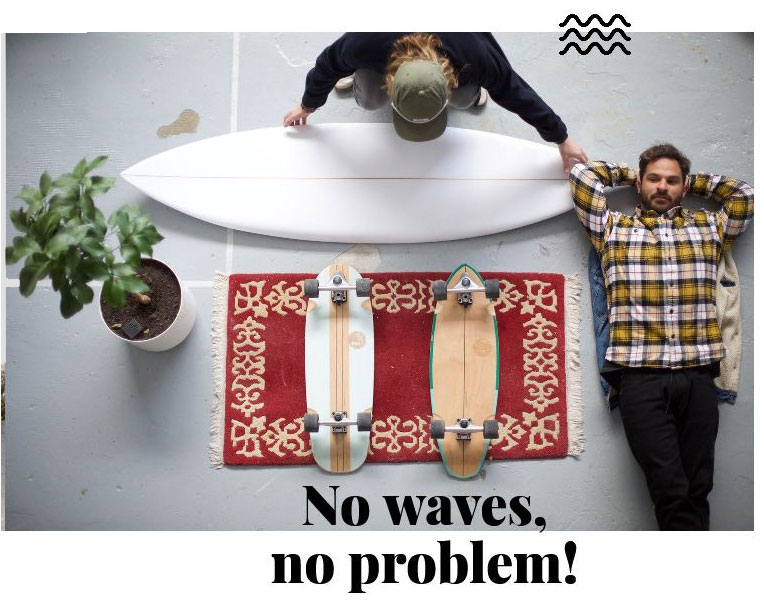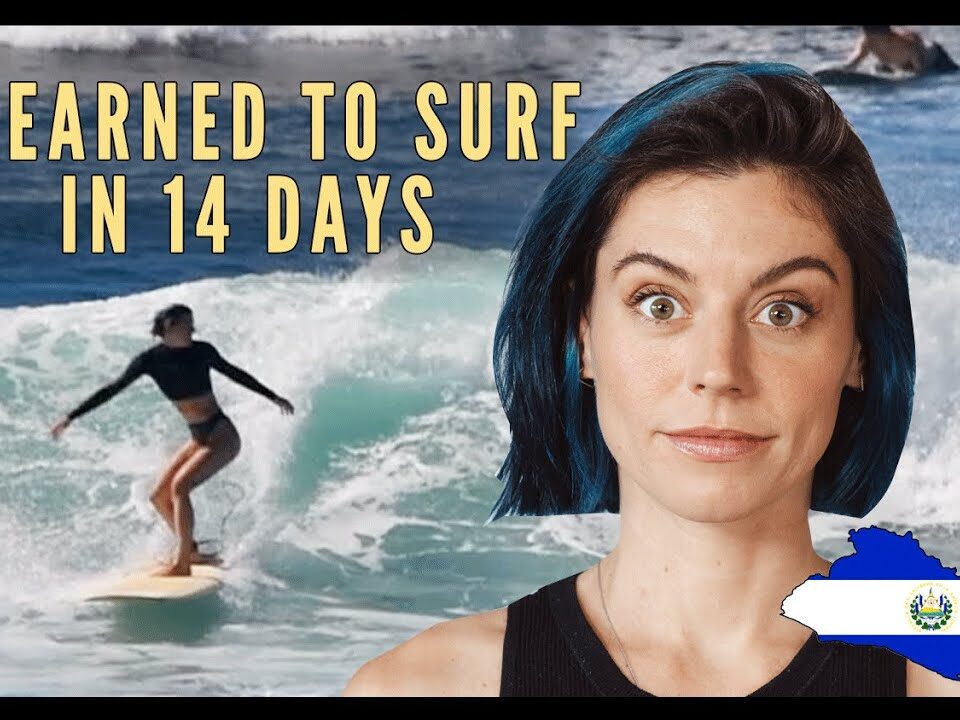
40 Family Activities in the Basque Country

Joel de Rosnay: Why learn to surf?
Surfing is an exciting sport, but it’s essential to understand the basics and prepare properly before taking to the waves. In this first chapter, we’ll look at the equipment you’ll need and the safety measures you should take to ensure that you surf with complete peace of mind.
Contenus de la page
How do I get started surfing?
– SAFETY RULES FOR LEARNING THE BASICS OF SURFING :
- 1 / Respect the “one per wave” principle.
- 2 / Avoid disturbing a surfer already on a wave if you are a beginner…
- 3 / Do not go into the bathing area to surf…
- 4 / ! Don’t swim against the current!
Before you start surfing, remember that surfing is a complete sport, so you can improve your physical and mental fitness as well as your feeling for the ocean or sea!
A few tips to help you get off to a good start in surfing:
- Choose a surfboard suited to your level. As with any sport, it’s important to be well equipped and not to start out with equipment reserved for professionals…
- Start on the beach with a thorough warm-up.
- Try to position yourself on the board (always on the beach).
The recommended age for a child to start is 6, although there are obviously exceptions.
We’ll come back to this point later!
Is it difficult to learn to surf?
Don’t leave anything to chance and take the time to prepare well for your first sessions so that you can move forward effectively.
Make sure you have :
- A suitable surfboard.
- A suitable wetsuit.
- A good leash.
- Wax
- Goofy / Regular, what’s your front foot on your board?
How do you position yourself on a surfboard?
To paddle, when you go looking for waves, lie down in the middle of your board or a little bit behind it, raise your torso slightly when you paddle to position yourself and bring your body closer to the board when you paddle to pick up speed and potentially catch a wave.
Once you’re up on the board, stay flexed with your eyes looking off into the distance, where you want to go!
Things not to do :
- Paddle with both arms at the same time.
- Splash around in the water, especially if you’re with other surfers.
- Rest your head on the board.
In most cases, surfers put their ‘strongest’ foot at the front of the surfboard (the foot you kick a football with). Note that this is not always the case.
When to catch a wave when surfing?
There are times during the day when conditions are optimal for surfing, but as a general rule, the best time to surf is between 2 and 4 hours after the start of the rising tide.
To catch a wave, you need to take a number of factors into account, including the series, your position and other surfers. If you can stand next to an experienced surfer without disturbing him, that’s great!
You’ll be able to observe his movements, understand when to turn round, when to start rowing, which way to go and when to get up…
When should you do your take-off?
To make a correct take-off, you need to concentrate on timing at all costs – it’s the first variable to take into account. A late take-off or one that arrives too early will never allow you to catch a wave.
If the wave breaks to the right, paddle more and more in the same direction as the wave arrives.
The hardest part is getting up, try to get up as quickly as possible while keeping a reasonable balance.
How can I improve my take-off?
When you’re a beginner, it’s very difficult to surf backside waves. You’ll feel more comfortable if you can see the wave you want to surf.
How do you avoid a “nose dive” when surfing?
You have to give it your all when you paddle, especially when you can feel the back of your board climbing the wave. The right position on your board is the key.
If you’re nose-diving too often, it may be because of your position on your board. If you’re too far forward, you’re bound to go over the top of your board. The shape of your board can also be a factor, too much rocker, not enough bedding…
Which surfboard should you choose to improve?
If you surf occasionally, you’ll prefer a hybrid board like the mini-Malibu, which is more than sufficient for beginner to intermediate surfers.
| weight (kg) | Beginner | Medium |
|---|---|---|
| 70 kilograms | 49 L. | 30 litres |
| 73 kilograms | 50 litres | 31 L. |
| 75 kilograms | 52 L. | 32 litres |
| 77 kilograms | 54 litres | 33 L. |
There are 4 main factors: length, width, thickness and size. The higher the bedding, the more stable the board and the more suitable it is for less experienced surfers.
| Beginner surfer weight | Board size |
|---|---|
| 55 to 65 kg | 6’8 – 7 – 4 – |
| 65 to 75 kg | 7’4 – 8 – 6 – |
| 75 to 85 kg | 8’6 – 9 – 2 – |
| 85 to 95 kg | 9’2 – 9 – 6 – |
Before we get started, here’s a quick glossary on how to choose a surfboard:
- Fish: short, wide board for surfing small waves.
- Malibu: the perfect board for beginners, with plenty of room and comfort.
- Mini-malibu: malibu but smaller for a little more manoeuvrability.
- Shortboard: board for experienced surfers, fairly small, light and with little weight for good liveliness.
- Hybrid: A good compromise for intermediate surfers, with the performance of a shortboard and the comfort of a mini-malibu.
- Gun: Long board specially designed for surfing very big waves.
- Duck Dive: Passing under the wave to continue to the spot.
Rules and advice :
You’re about to learn to surf in Biarritz, so now’s the time to learn the basics of surfing rules and codes. By filming a short tutorial on surfing and swimming! So we’ve decided to show you everything you shouldn’t do… to avoid doing it, of course! Our teachers for the day, the famous big wave rider Michel Larronde and the experienced René Dubès, tried to be patient… Yes, they tried! But we had some good oats all the same! Here we go for a lesson you’re sure to remember!
We’re off for a hard-hitting review of the rules of surfing in the company of a renowned instructor. Meet the solid Michel Larronde! A regular on the French and Hawaiian line-ups, Michel is one of the best-known big-wave surfers in France. You’ll soon realise that his straight talk will put the noobs (beginners) back on the right track.
Rule no. 1: respect and localism
When you see other surfers meet your eyes, you simply say hello. Among all these surfers, there are local surfers who come ‘every day’ and who know each other, so try to fit in…
Rule no.2: Hold your board
When a series of waves arrives and you get it in the face, you don’t let go of your board. Behind you, there could be a guy who could take it in the face! Even if you’ve got a leash!
The leash is two or three metres long, depending on the strength of the wave.
Rule no.3: the surf zone
The swimming area is between the blue flags only. Between the green and blue flags is the bodyboarding area. For surfers, it’s outside the flags.
Wearing a helmet is recommended!
Rule No.4: Priority
In surfing there are priorities and if there’s a guy who’s already on the wave he’s got priority. You have to look at that before you get on the wave and you have to respect the priority!
Rule No.5: Use a leash
When you lose your board, anyone can take it in the face (at best in the feet!). There are surf shops everywhere, so go and buy yourself a leash, put on some surf clothes and stop being a clown, because it’s not going to happen like that!
Where can I learn to surf?
The Cote des Basques is a paradise for learning to surf in France.
Before you start surfing, remember that surfing is one of the most complex and difficult sports in the world.
Don’t leave anything to chance, and take the time to prepare well for your first sessions so that you can progress effectively.
What tide for surfing?
For beginners, it’s best to surf at low tide, as at high tide the waves are inconsistent. Surfing at high tide generally requires a large swell to be correct.
You can surf when the wind is very light. The tide corresponds to the movement of bodies of water associated with the gravitational attraction of the moon and the sun.
Offshore wind: wind that comes from the land and blows towards the sea. This alignment completely smoothes the water!
How do you read the waves?
The best way to get a good wave reading is to start on the beach, looking at where the surfers are, where the waves are breaking, in which direction they are breaking, whether the tide is rising or falling…
Once you’re in the water, you’ll be able to take a closer look at the waves and see where you stand in relation to what you saw when you were on the shore.
Joël Badina, an outstanding bodysurfer and lifeguard, gives us the keys to a better understanding of the ocean! Having practised his profession with passion, performed a number of rescues that have been relayed all over France, and having caught some monstrous waves, Joël Badina has all the knowledge we need to understand the ocean. With his simple, methodical approach, this bodysurfer reassures us and makes us want to push ourselves! (Without going into waves that aren’t our level!) #staysafe
How do you surf big waves?
The trick is to sit about 4-5m away from where the waves usually break. Otherwise, you’re more likely to catch a powerful foam or even a wave that breaks on you and your board. The other tip is to sit next to an experienced surfer.





Eco-friendly sun creams to reduce our environmental impact
Read more